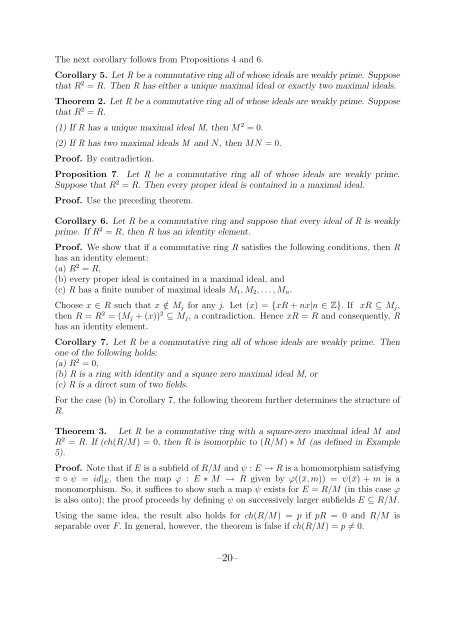Yasuyuki Hirano, Edward Poon and Hisaya Tsutsui
Yasuyuki Hirano, Edward Poon and Hisaya Tsutsui
Yasuyuki Hirano, Edward Poon and Hisaya Tsutsui
Create successful ePaper yourself
Turn your PDF publications into a flip-book with our unique Google optimized e-Paper software.
The next corollary follows from Propositions 4 <strong>and</strong> 6.<br />
Corollary 5. Let R be a commutative ring all of whose ideals are weakly prime. Suppose<br />
that R 2 = R. Then R has either a unique maximal ideal or exactly two maximal ideals.<br />
Theorem 2. Let R be a commutative ring all of whose ideals are weakly prime. Suppose<br />
that R 2 = R.<br />
(1) If R has a unique maximal ideal M, then M 2 = 0.<br />
(2) If R has two maximal ideals M <strong>and</strong> N, then MN = 0.<br />
Proof. By contradiction.<br />
Proposition 7. Let R be a commutative ring all of whose ideals are weakly prime.<br />
Suppose that R 2 = R. Then every proper ideal is contained in a maximal ideal.<br />
Proof. Use the preceding theorem.<br />
Corollary 6. Let R be a commutative ring <strong>and</strong> suppose that every ideal of R is weakly<br />
prime. If R 2 = R, then R has an identity element.<br />
Proof. We show that if a commutative ring R satisfies the following conditions, then R<br />
has an identity element:<br />
(a) R 2 = R,<br />
(b) every proper ideal is contained in a maximal ideal, <strong>and</strong><br />
(c) R has a finite number of maximal ideals M 1 , M 2 , . . . , M n .<br />
Choose x ∈ R such that x /∈ M j for any j. Let (x) = {xR + nx|n ∈ Z}. If xR ⊆ M j ,<br />
then R = R 2 = (M j + (x)) 2 ⊆ M j , a contradiction. Hence xR = R <strong>and</strong> consequently, R<br />
has an identity element.<br />
Corollary 7. Let R be a commutative ring all of whose ideals are weakly prime. Then<br />
one of the following holds:<br />
(a) R 2 = 0,<br />
(b) R is a ring with identity <strong>and</strong> a square zero maximal ideal M, or<br />
(c) R is a direct sum of two fields.<br />
For the case (b) in Corollary 7, the following theorem further determines the structure of<br />
R.<br />
Theorem 3. Let R be a commutative ring with a square-zero maximal ideal M <strong>and</strong><br />
R 2 = R. If (ch(R/M) = 0, then R is isomorphic to (R/M) ∗ M (as defined in Example<br />
5).<br />
Proof. Note that if E is a subfield of R/M <strong>and</strong> ψ : E → R is a homomorphism satisfying<br />
π ◦ ψ = id| E , then the map ϕ : E ∗ M → R given by ϕ((¯x, m)) = ψ(¯x) + m is a<br />
monomorphism. So, it suffices to show such a map ψ exists for E = R/M (in this case ϕ<br />
is also onto); the proof proceeds by defining ψ on successively larger subfields E ⊆ R/M.<br />
Using the same idea, the result also holds for ch(R/M) = p if pR = 0 <strong>and</strong> R/M is<br />
separable over F. In general, however, the theorem is false if ch(R/M) = p ≠ 0.<br />
–20–















